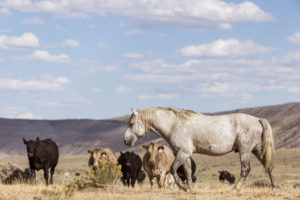For Immediate Release – May 3, 2023
Media Contact –
Michael Saul, Western Watersheds Project, 303-915-8308; michael@westernwatersheds.org,
DENVER, Co. – Today, the Colorado Parks and Wildlife Commission unanimously approved a plan that paves the way for the state to begin translocating gray wolves into Colorado by the end of 2023. The Commission also approved rules that authorize both private individuals and state agents to kill wolves under a variety of circumstances, a management tool that runs counter to the best available science about the species.
The restoration of wolves is being done in accordance with Colorado’s 2020 citizen-initiated Proposition 114, which requires Colorado Parks and Wildlife (“CPW”) to bring back the native predator. The voter initiative, as subsequently codified into state law, requires that CPW develop a plan to restore and manage gray wolves in Colorado, “using the best scientific data available.” “Restoration” is defined as reintroduction of wolves plus “post-release management of the gray wolf in a manner that fosters the species’ capacity to sustain itself successfully.”
“We appreciate the hard work of Colorado Parks and Wildlife in bringing the gray wolf back to Colorado,” said Michael Saul, Colorado Director with Western Watersheds Project. “But Colorado voters were quite specific, in mandating not just wolves, but a science-based management plan leading to a self-sustaining population of wolves and restoration of a missing ecological balance. The rules adopted by the Colorado Parks and Wildlife Commission fall short of this standard.”
The new rules rely on the scientifically-refuted assumption that killing wolves will foster humans’ tolerance for wolves, and in adopting highly permissive guidelines for wolf killing, without consideration of the effects on pack and population viability.
One provision retroactively authorizes ranchers to kill wolves “in the act” of attacking livestock or dogs, which is defined as “chasing, molesting or harassing by wolves that would indicate to a reasonable person that such biting, wounding, grasping, or killing of livestock is likely to occur at any moment.” The second provision allows CPW to issue permits, including to private individuals for the killing of “chronically depredating” wolves on both public and private lands, following a single allegation of wolf depredation on livestock or working dogs. The rules do not set any numerical limits on the number of wolves that can be killed, nor require consideration of the viability or stability of wolf packs prior to issuance of lethal take permits.
“Coloradans didn’t come this far forward in wolf recovery to take two steps back in terms of permissive management that allows wolf killing,” said Saul.
Following a lengthy campaign of state-sponsored eradication, gray wolves were extirpated from Colorado in approximately 1944. The species has been federally listed as endangered in Colorado under the Endangered Species Act since 1976, and, apart from a brief interval of illegal delisting from 2021 to 2022, has remained so listed since. Gray wolves in Colorado are currently under federal management and cannot legally be killed or harmed under federal law absent certain narrow permits from the Fish and Wildlife Service.






